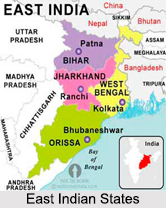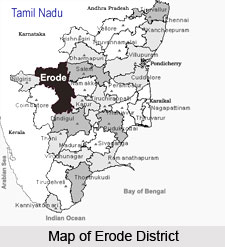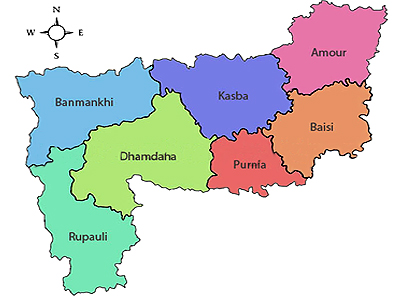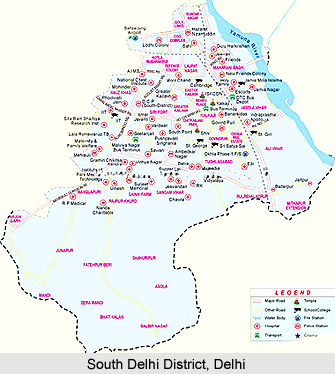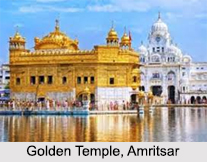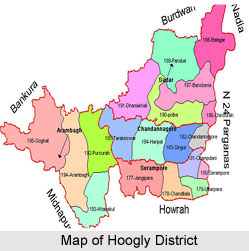Tribes of Karbi Anglong District mirror the tribal world and the tribal culture of the Anglong District. As the great historian of Assam Dr. Surya Kumar Bhuyan observes a vital lesson which the tribal can teach us is their self-sufficiency in domestic economy. And the lesson is but a didactic moral when it comes to the life of million mortals. The tribes are less dependent on supplies from outside.
Although that makes them confined to the culture and economy of their life, the issue of economic independence and the one of specialization of labour can hardly be avoided. The Anglong craft here therefore bears the nuances of the ancient tradition of the ethnic culture which the people cherish with pride. They carve out utensils from wood; they spin out cotton and make quilts and traditional apparels. In other words the craft of hill areas is a rare combination of aesthetic and technical intricacy.
A large numbers of Tribal Communities swarm the area some of them being The Dimasas in Dhansiri / Mohendijua area. The Bodos in Langhin area, Kuki / Thadou / Hmar Tribes in Singhason and Koilamati areas, Tiwas in the areas bordering Nagaon and Morigaon District. Garos in Hamren Sub-division. The Man-tai speaking community inhabiting in Bokajan Sub-Division are some of the community tribes. Some Khasi Tribes inhabiting in areas adjoining Meghalaya mostly in Hamren Sub-Division, Scattered population of Chakmas mostly in Borlangphar area, Rengma Nagas in Nilip Block area.
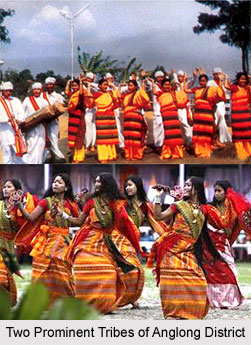 The Karbis tokenised as the Mikirs in the Constitution Order, Govt. of India, constitutes of a vital ethnic group in the hill areas of Assam. However, they prefer calling themselves as Karbi instead of Mikir and sometimes Arleng which literally refers to a man. Although at present, they are found to inhabit in the Karbi Anglong District, nevertheless, some Karbi inhabited pockets are found in the North Cachar Hills, Kamrup, Morigaon, Nagaon District and Sonitpur Districts also. Apart from the original Karbi Tribes, there are also a large number of other tribal communities residing in the district.
The Karbis tokenised as the Mikirs in the Constitution Order, Govt. of India, constitutes of a vital ethnic group in the hill areas of Assam. However, they prefer calling themselves as Karbi instead of Mikir and sometimes Arleng which literally refers to a man. Although at present, they are found to inhabit in the Karbi Anglong District, nevertheless, some Karbi inhabited pockets are found in the North Cachar Hills, Kamrup, Morigaon, Nagaon District and Sonitpur Districts also. Apart from the original Karbi Tribes, there are also a large number of other tribal communities residing in the district.
The Karbis have 5(five) clans called "KUR". These are Terang, Teron, Enghee Ingti and Timung. Each of the five clans again is divided into some sub clans. While Enghee and Timung have 30(thirty) sub-clans each, Terang and Teron have 6(six) sub-clans each and the remaining clan Ingti has only 4(four) sub-clans. These clans are completely exogamous and a nuptial knot between a boy and a girl belonging to the similar clan can is bound not to happen as the children of the same clan are considered as brothers and sisters. Desecration of this perennial customary law obviously leads to ex-communication of the couple involved. Again after death the classification of the clans is kept in action. The cremation ground called Tipit or Thiri, area is kept demarcated for each clan. Although all the five clans are socially on the similar level based on equality, Ingti being a clan of the priestly order, the clan was supposed to have a higher status in former times.
In spite of monogamy being the prevailing practice, there is no bar to polygamy and the cases of polygamy are very rare. Cross-cousin marriage is a preferential one. Like other tribal societies, the Karbis do not have the system of bride price. After marriage, the wife continues to use the surname of her father. But the children assume the title of their father. Thus, the Karbis follow the patriarchal system of family structure.
Racially the Karbis belong to the Mongoloid group whereas linguistically they belong to the Tibeto-Burman group. The original home of the various people speaking Tibeto-Burman languages was in western China near the Yang-Tee-Kiang and the Howang-ho rivers and from these places they went down the courses of The Brahmaputra Basin, the Chindwin and the Irrawaddy and entered India and Burma.
The Kabis, along with others entered Assam from Central Asia in one of the waves of migration. But, it is very difficult to trace the history of the early settlement of the Karbis bereft of any written documents and other evidence like archaeological remains, etc. Of course, in the old chronicles and Buranjis occasional references here and there were made to the people of this race. But from these references also it is very difficult to trace the chronological events of the Karbis. Their folk-tales and folk-lore are the only sources from which it can have an idea regarding their early history.
The folk-lore of the Karbis, however, indicate that during the long past, once they used to live on the banks of the rivers the Kalang and the Kapili and the entire Kajiranga area, the famous National Park situated in Assam, was within their habitation. During the reigns of the Kachari kings, they were driven to the hills and some of them entered into Jaintia hills, the erstwhile Jaintia kingdom and lived under the Jaintia suzerainty.
While a section of the Karbis remained in the Jaintia kingdom, others moved towards north-east by crossing the river Barapani, a tributary of the Kapili and entered into the Rongkhang Ranges. There they established their capital at a place called Socheng. Those who continued to live under the suzerainty of the Jaintia king had to face constant harassment at the hands of the Jaintias and this had compelled them to migrate towards north ward. A good number of them had entered into the Ahom territory and prayed for protection from the Barphukan at Raha. Thus migration took place at the beginning of the 17th Century. The Karbis who migrated to the Ahom kingdom had to face the Burmese invasion. The Burmese who invaded Assam perpetrated inhumane oppression on the people. The Karbis took refuge in the deep jungles and high hills leaving their hearth and home in the surmounting regions. In order to save themselves from the greedy eyes of the Burmese invaders, the young Karbi girls started to use a black line from the forehead to the chin which is known a "DUK" with a view to making them ugly looking. While some of the Karbis migrated to lower Assam, some had crossed the Brahmaputra and settled in the north bank.
